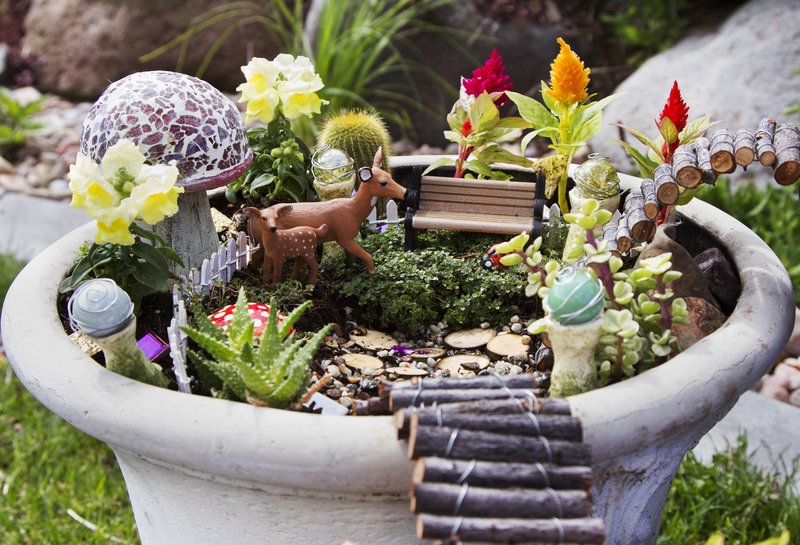Wind-Resilient Gardening Practices Explained
Posted on 03/09/2025
Wind-Resilient Gardening Practices Explained
Gardening is a delightful pursuit, but one major challenge can uproot even the most seasoned horticulturists: wind. Understanding and employing wind-resilient gardening practices is essential for protecting your plants, preserving your landscape, and fostering a thriving, beautiful outdoor space. This comprehensive article explores effective techniques for creating a wind-resistant garden, guiding you step-by-step from design to maintenance.
Why Wind Poses a Threat to Gardens
Winds, whether persistent breezes or furious gales, can cause significant damage to gardens. If left unchecked, they can:
- Break or uproot young and fragile plants, leading to loss of both yield and ornamental value.
- Accelerate evaporation, causing soil to dry out quickly, stressing crops and flowers.
- Spread diseases by carrying spores and pests from neighboring areas.
- Dislodge mulch and topsoil, leading to soil erosion and loss of nutrients.
- Inhibit pollination by interfering with insect activity, which can affect fruit and seed set.
Given these challenges, it becomes crucial for gardeners to adopt wind-resilient gardening strategies to ensure their plants not only survive but thrive, regardless of exposure.

Key Principles of Wind-Resilient Garden Design
Building a wind-resistant landscape starts with careful planning. Integrating the following principles at the design stage pays dividends and minimizes ongoing maintenance.
1. Evaluate Wind Exposure and Patterns
Not all areas in your garden endure the same wind intensity. To develop effective windbreak gardening practices:
- Watch how wind moves around your property at different times of the year.
- Take note if wind is funneled by natural features like hills, buildings, or fences.
- Identify your garden's most exposed and sheltered spots.
Mapping these variables helps target your wind deflection and mitigation efforts, ensuring your wind-resilient garden design matches site-specific challenges.
2. Create Effective Windbreaks and Shelters
Windbreaks are the primary defense against wind damage. While solid barriers block wind, they can create turbulence on their leeward sides. A windbreak that filters wind, reducing its speed without sudden drops, is generally more effective.
- Living windbreaks: Hedges and dense rows of trees or shrubs offer natural, attractive protection. Good options include conifers, willows, privet, hawthorn, or holly.
- Constructed barriers: Lattice fences, woven bamboo screens, and slatted wooden panels work well, allowing some air to pass through and minimizing swirling gusts.
For maximum effectiveness, ensure your windbreak:
- Is permeable; allow 40-50% of air to filter through.
- Has a height at least equal to the area you wish to protect; the sheltered zone can extend up to 10 times the windbreak's height downwind.
- Is oriented perpendicular to prevailing winds.
- Has staggered plantings or panels for best coverage.
With time, as plants grow fuller, your wind-resilient garden will become less vulnerable to sudden gales.
3. Utilize Strategic Planting and Zonation
Another core wind-resilient gardening tactic is grouping plants by their tolerance levels and placing tougher species on the front lines.
- Wind-tolerant species: Use sturdy specimens such as juniper, ornamental grasses, or New Zealand flax as buffers. These help absorb the brunt of wind, protecting more delicate crops behind them.
- Zoning: Arrange sensitive plants (lettuce, tomatoes, many annual flowers) behind windbreaks or within naturally sheltered corners.
- Staggered layers: Try a layered approach, with trees, medium-height shrubs, and then lower-growing flowers and vegetables. This structure creates multiple levels of wind resistance.
By layering and intelligently zoning your plants, you improve airflow, encourage healthy growth, and enhance your garden's resilience.
4. Choose Wind-Resistant Plant Varieties
Selecting the right plants is foundational for any wind-proof garden.
- Native species: Local plants have natural adaptations, such as tough, waxy leaves or flexible stems, that help them withstand gusty conditions.
- Deep-rooted plants: These anchor themselves more firmly and are less likely to suffer windthrow or uprooting. Examples include oaks, pines, and many prairie perennials.
- Flexible and low-growing types: Groundcovers such as creeping thyme or vinca, and flexible, bending grasses, cope far better than tall, spindly varieties.
Tip: When in doubt, consult your local nursery for specific recommendations on wind-tolerant plants tailored to your climate and garden conditions.
Essential Wind-Resilient Gardening Techniques
Supporting and Securing Plants
Even with the best windbreaks, young trees, tender saplings, and tall productions often need extra support, especially in exposed gardens. Consider:
- Staking: Use soft ties to loosely attach saplings to stakes, allowing some movement (which strengthens stems). Remove stakes after 1-2 years as roots establish.
- Cages and frames: Tomatoes, beans, and climbers benefit greatly from sturdy frameworks that prevent snapping or uprooting in high winds.
- Guy wires: Use for larger trees that require stabilization, but avoid girdling the trunks--always pad contact points.
This form of physical support is a core part of any wind-resistant gardening practice.
Soil Management for Windproof Gardening
Wind tends to dry out and erode exposed soil. Maintaining robust and healthy soils will ensure your garden weathers storms better:
- Mulching: Spread organic matter--like straw, bark, or compost--thickly around plants. This limits evaporation, protects surface roots, and prevents soil from blowing away.
- Groundcovers: Living mulch (such as clover or creeping perennials) both stabilizes soil and offers additional wind buffering.
- Soil improvement: Build organic content and structure by adding compost, which increases water retention and root anchorage.
Healthy and protected soil is your garden's foundation for wind resilience.
Flexible Gardening Structures and Solutions
Not all wind-protection needs are permanent. For vegetables or annual beds, lightweight and temporary wind shelters can be erected as needed:
- Row covers and cloches: Fabric tunnels, glass bells, or plastic domes offer quick defense during periods of high winds.
- Temporary fencing: Repositionable netting or stake-and-sheet systems can shield raised beds during stormy seasons.
Employing such portable wind protection allows for flexibility while minimizing long-term visual impact.
Consistent Maintenance and Monitoring
Part of a successful wind-resilient garden is ongoing attention:
- Regularly inspect windbreaks and replace dead or damaged plants.
- Re-secure ties and supports after storms.
- Replenish mulch and compost as it breaks down.
- Prune trees and shrubs to maintain strong, open structures and prevent excessive sail-like mass at the canopy top.
Staying vigilant ensures your investment in wind-resistant landscaping continues to pay off over the years.
Popular Wind-Resistant Plants For Every Garden
Trees
- Pines (particularly Pinus nigra or Austrian Pine)
- Holly (Ilex aquifolium)
- Oak (Quercus spp.)
- Hawthorn (Crataegus spp.)
- Alder (Alnus glutinosa)
Shrubs
- Boxwood (Buxus sempervirens)
- Escallonia
- Privet (Ligustrum spp.)
- Sea Buckthorn (Hippophae rhamnoides)
Perennials and Groundcovers
- Ornamental Grasses (such as Miscanthus or Panicum)
- Creeping Thyme
- Ajuga
- Sedum
Introducing resilient species into your garden is the cornerstone of wind-resilient landscape management.
Urban Gardens: Special Tips for Wind Management
Wind can be even more intense around high-rise buildings or alleyways, posing unique challenges for urban gardeners. Try these methods:
- Use modular planters: Group containers tightly together to create mutual wind shelter.
- Place taller pots on the leeward side: Let robust bamboo, palms, or oleanders break and filter wind.
- Install trellises with climbing plants: These soften and diffuse gusts while maximizing greenery and color.
Attention to microclimates in urban gardens is a modern approach to wind-resistant gardening.

Frequently Asked Questions about Wind-Resilient Gardening
Can I make an existing garden more wind resistant?
Absolutely! Even mature gardens benefit from incremental improvements. Add strategic fencing, introduce tough shrubs, increase mulching and groundcover, and consider shifting sensitive plants into more protected areas.
How does wind affect vegetable yields?
Wind can dry out the soil, stress tender crops, break stalks, and interfere with pollination. Following wind-proof gardening practices, like installing row covers and building living hedges, can safeguard and even boost your yields.
What if severe winds are rare in my region?
Even infrequent gales can cause serious damage. Proactive wind-resilient landscape design ensures your garden recovers quickly and minimizes losses, paying for itself even if only used occasionally.
Should I use solid or slatted fences for wind protection?
Slatted or permeable fencing is far superior. Solid walls force wind up and over, triggering turbulence that can worsen damage on the sheltered side. Slatted fences filter wind, slowing and diffusing it more gently.
Which mulches are best for exposed gardens?
Heavier organic mulches such as wood chips, bark, or composted manure tend to stay put better than leaf or straw under strong winds. Living mulches and low groundcovers add extra protection.
Conclusion: Building a Wind-Resilient Garden That Thrives
Wind need not be the undoing of your gardening ambitions. By analyzing site conditions, installing layered windbreaks, choosing tough and appropriate plants, and employing reliable staking and mulching techniques, you build a robust, wind-resistant garden from the ground up.
Every garden is unique: experiment with combinations of living and artificial wind barriers, nurturing your soil and observing how your landscape responds to different interventions.
Wind-resilient gardening is both an art and a science--one that ensures your outdoor sanctuary remains protected, beautiful, and productive for years to come, regardless of what the weather brings.
Further Reading and Resources:
- RHS: Creating Wind-Resistant Gardens
- Gardeners' World: How to Windproof Your Garden
- Gardenia: Best Windbreak Plants
Start transforming your landscape today with expert wind-resilient gardening practices and watch your garden flourish--even when the wind blows the hardest!

